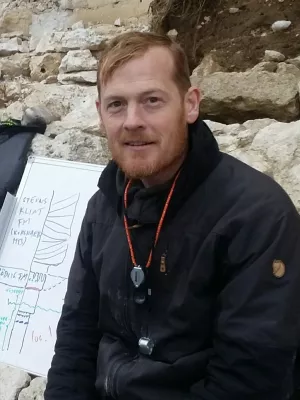
Mikael Calner
Professor

A lowstand epikarstic intertidal flat from the middle Silurian of Gotland, Sweden
Author
Summary, in English
This paper describes the sedimentology, morphology and diagenesis of recently discovered Middle Silurian low-relief micro-epikarst from the Klintehamn area on western Gotland (Sweden). The epikarst represents the most distal portion of an unconformity that truncates stratigraphic units across a major part of the Baltic palaeo-basin. It formed in the intertidal area during the late stage of platform development and following a short period of regression and siliciclastic influx to the basin at the closing of the Cyrtograptus lundgreni Chron, An overlying oncolite shows signs of repeated exposure to meteoric and marine waters, supporting the interpretation of a karstic flat setting. Four microfacies with different stable isotopic signatures are recognised across the unconformity: dolomitic siltstone and altered siltstone in the topmost Frojel Formation, below the contact, and ferruginous crinoid algal packstone and ferruginous oncolite grainstone above the contact, in the basal lag of the transgressive Halla Formation. Endolithic structures of inferred fungal/algal origin occur frequently in the two transgressive microfacies. The set of observations pointing towards subaerial exposure and karstic processes include: (a) an understanding of the regional geology; (b) erosional relief with undercutting and an associated conglomerate; (c) vertical and subvertical conduits (karren), indicating gravitationally controlled waters; (d) widening of fissures and subsequent polyphase fillings (splitkarren); (e) eluviated, internal sediment (e.g,, crystal silt); (f) blackening; (g) repeated etching of carbonate allochems; (h) a fitted grain-fabric; (i) circum-granular cracking; (j) pendant nonluminescent cements; (k) abundant intercrystalline and intergranular (secondary) porosity, and (1) anomalous stable isotopes. A synsedimentary iron-crust at the contact was not related to karstification but formed a few centimetres below the sediment surface during the ensuing transgression. (C) 2002 Elsevier Science B.V. All rights reserved.
Department/s
- Lithosphere and Biosphere Science
Publishing year
2002
Language
English
Pages
389-403
Publication/Series
Sedimentary Geology
Volume
148
Issue
3-4
Document type
Journal article
Publisher
Elsevier
Topic
- Geology
Keywords
- stable isotopes
- Silurian
- epikarst
- Gotland
Status
Published
ISBN/ISSN/Other
- ISSN: 0037-0738

